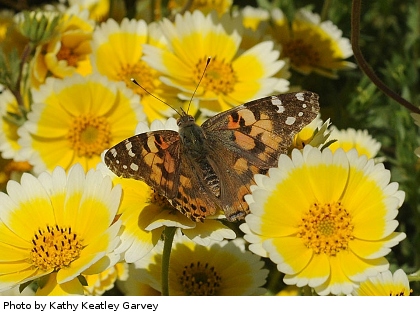The migration of the Painted Lady butterfly (Vanessa cardui) was especially large this year, and Art Shapiro's Butterfly Website was an invaluable tool in tracking this migration over the last month and a half.
Dr. Shapiro has posted regular updates regarding the status of this migration, based on his own observations as well as those sent to him through the website contact form by butterfly enthusiast across the state. We have compiled many of these emails and created a second website page of these observations, for everyone's benefit. This community effort has been a remarkable example of citizen science, and has enabled us to track this migration from Southern California northward through Davis and other collection sites which Dr. Shapiro visits regularly. The first major wave of Painted Ladies from the desert showed up in mid-March at Mammoth Lakes, and north-central California has seen has seen subsequent waves across the state, reaching its peak in early April. Currently, the numbers have dwindled, but these butterflies are still very common for this region. Some of these butterflies continue north to Oregon, Washington, and even into British Columbia.
The Painted Lady migration occurs yearly, but this year's migration is the largest since 2005, when the air was full of this species and traffic was affected. Dr. Shapiro estimates this migration being about 1/3 the size of the 2005 migration.
The Butterfly Website website describes over 36 years of data collected by Dr. Arthur Shapiro, professor of Evolution and Ecology at the University of California, Davis. Dr. Shapiro regularly visits ten sites across central California ranging from the Sacramento River delta, through the Sacramento Valley and Sierra Nevada mountains, to the high desert of the western Great Basin; these sites represent the great biological, geological, and climatological diversity of central California.
The website was developed at ICE with support from a National Science Foundation Biological Databases and Informatics Grant DBI-0317483.

